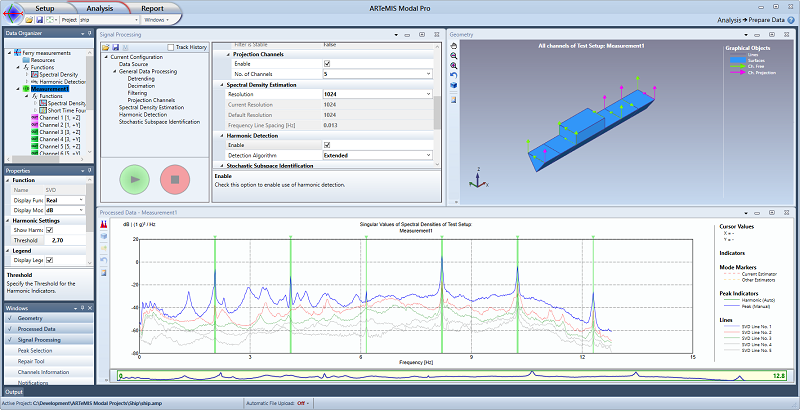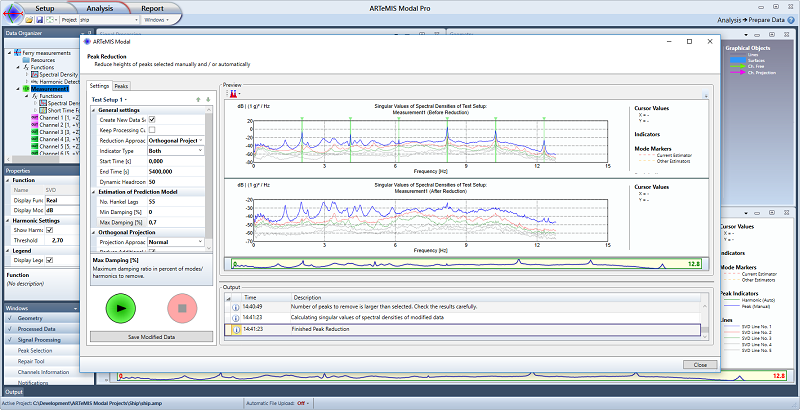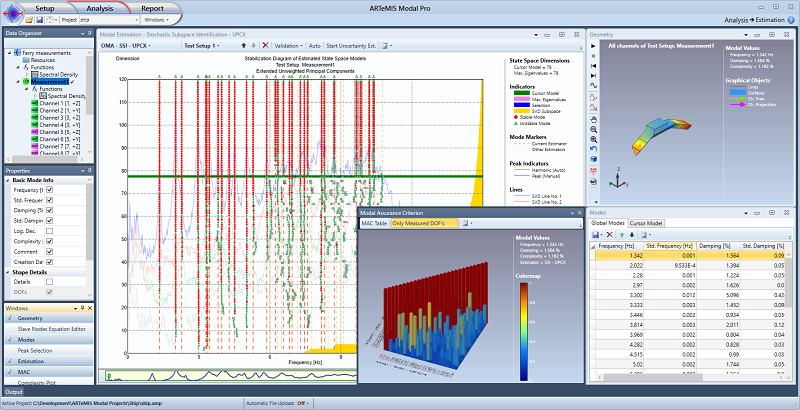Operational Modal Analysis of a Ship in the Presence of Harmonic Excitation
This case study demonstrates how the use of Harmonic Detection and Peak Reduction makes it easy to estimate modes from of a ship, even in the presence of significant harmonic excitation. The measurements and analysis presented here have been performed by University of Rostock, Faculty of Mechanical engineering. Chair of Technical Mechanics.
The measurements have been made under fully operational conditions; the responses are recorded using a 16 channel acquisition system and sampled with 128 Hz. Here the data has been analyzed up to 12.8 Hz as there are no modes of interest above this frequency.
One of the major challenges has been a severe harmonic peak very close to the resonance of one of the fundamental modes of the structure. Additional orders of this harmonic frequency are also very significant in energy. A higher order mode at 8.2 Hz is masked by the harmonics of the same frequency. The aim of this analysis is to remove the harmonic peaks that render the operational modal analysis of this data less effective, and to estimate the global modes of the ship.
Technical Specifications of the Ship
The ship tested has the following technical specifications:
- Build at Flensburger Schiffbau Gesellschaft.
- Dimensions: length over all: 199.8 m
- Speed: 22.5 kn
- Main engine: 9L 60 MC-C (MAN B&W, 9 cylinder)
- Power: 20.070 kW
- Speed: 123 rpm
- Working process: two-stroke
- 4-bladed propeller with controllable pitch
Step 1 - Detection of Harmonic Excitation Peaks
The first step is to use the harmonic detection available in ARTeMIS Modal. This detection loops through the measurement channels applying a sliding bandpass filter to determine the level of Kurtosis at different frequencies. In the Fast Detection approach only a few potential frequencies are evaluated, whereas in the Extended Detection approach all frequencies, available in the corresponding spectral density spectra, are evaluated.
If the Kurtosis at a frequency drops much below 3, then it is a sign that the data at this particular frequency isn't normally distributed, which is the usual case of modal response from several independent input sources. In this case a green indicator is shown to signal that the data at this particular frequency might be from some rotating component rather than from a mode.
Below the Extended Detection has been applied. The green indicators are clearly showing at what frequencies the harmonic peaks are located.

Step 2 - Reduction of Harmonic Excitation Peaks
Once the most significant harmonic peaks have been identified, the second step is to perform a reduction of these peaks as well as other very lightly damped modes (<0.7%). The results of the harmonic peak reduction are illustrated on the figure below. The top diagram presents the Singular Values of the spectral densities of the original measurements as well as the six harmonic peaks to reduce. The bottom diagram shows the modified data after reduction.

Estimation of Modes
Estimation of the modes of the ship has been performed using the UPCX Crystal Clear SSI method with built-in uncertainty estimation of the modes. In this case state space models with dimension from 1 to 120 has been estimated and a stabilization diagram constructed as seen in the figure below. The global modes have then been automatically extracted from the diagram taking the estimated uncertainties into account. This allow a very accurate extraction of more than 25 modes in the selected frequency band.

Related Information
A description of the peak reduction technique used in the case study can be found in the following papers:
S. Gres, P. Andersen, C. Hoen, L. Damkilde
Orthogonal projection-based harmonic signal removal for operational modal analysis
Proceedings of the 36th International Modal Analysis Conference (IMAC), Orlando, Florida, 2018.
S. Gres, P. Andersen, L. Damkilde
Operational Modal Analysis of Rotating Machinery
Proceedings of the 36th International Modal Analysis Conference (IMAC), Orlando, Florida, 2018.
The uncertainty estimation used in the UPCX method is described in the following award winning paper from IOMAC2017:
M. Döhler, P. Andersen, L. Mevel
Variance Computation of Modal Parameter Estimates from UPC Subspace Estimation
Proceedings of the 7th International Operational Modal Analysis Conference (IOMAC), Ingolstadt, Germany, 2017.
A more detailed, full-length analysis of this data can be seen in this YouTube video. This demonstration makes use of manually picking of the harmonic peaks instead of the automatic harmonic detection.